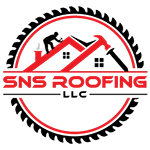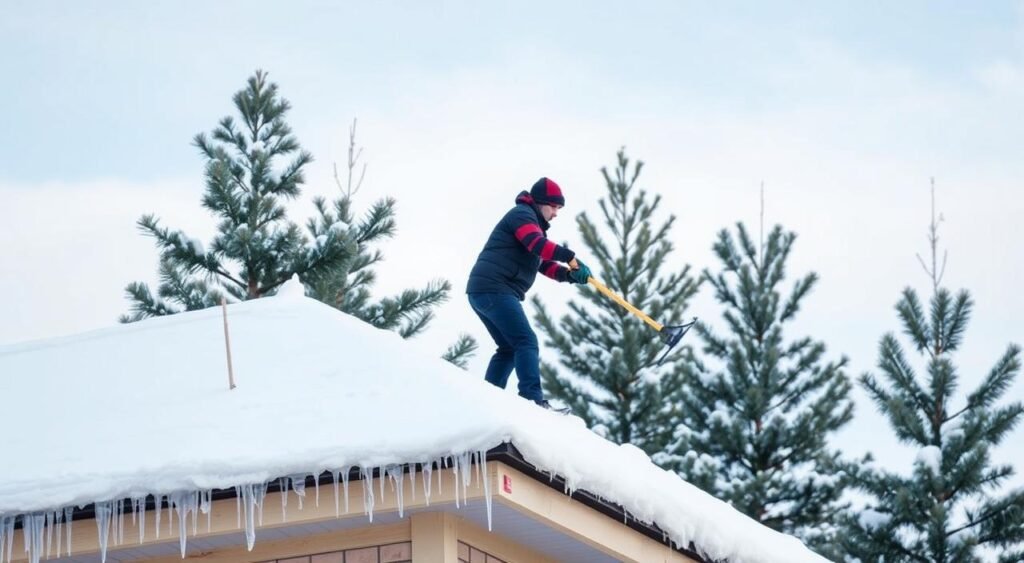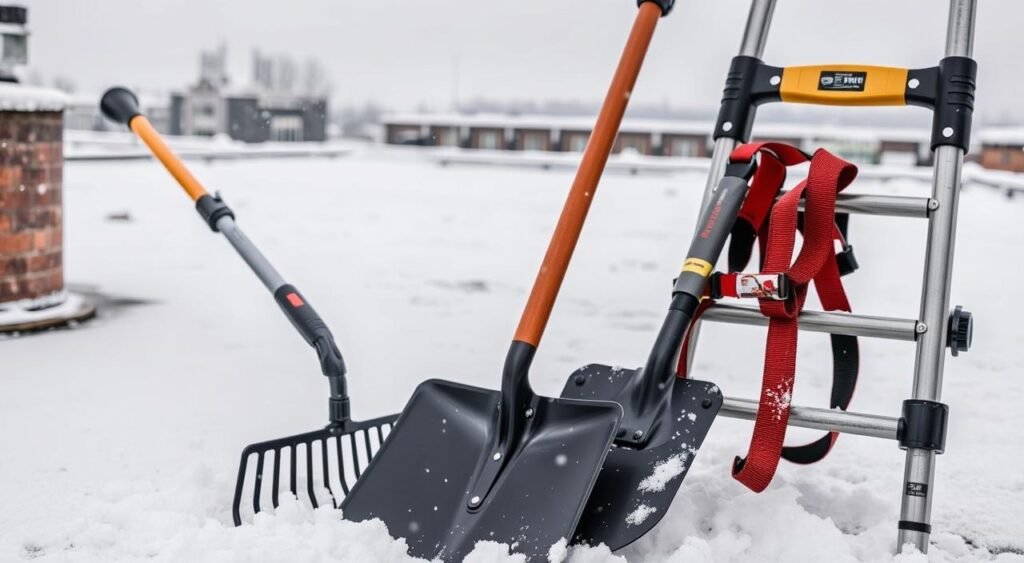Winter brings beauty and challenges. Last year, heavy snow led to a number of calls as people were concerned about the impact on their roofs. This was a wake-up call for the importance of roof maintenance and safety during winter.
This event led to discussions about the dangers of snow on roofs. We found out that too much snow can damage properties. More than a foot of heavy, wet snow can stress a roof.
Our guide covers key aspects of roof snow management. We talk about understanding snow weight and safe removal techniques. We also discuss the tools and methods for safe removal, and when to call professionals.
Let’s explore winter roof maintenance and safety together. We aim to keep our homes safe and cozy during the snowy months.
Key Takeaways
- Snow thicker than six inches can cause property damage
- Regular roof checks help prevent serious winter-related issues
- Professional help is safer for challenging snow removal tasks
- Proper tools and techniques are crucial for safe snow removal
- Monitoring weather forecasts aids in timely snow management
- Leaving a thin layer of snow protects the roof covering
- Review homeowners’ insurance for weather-related coverage
Understanding Snow Weight and Roof Load Capacity
Snow on roofs is more than just a winter scene. It’s important to know how much snow your roof can handle. Let’s explore the details of snow load capacity and why removing snow from roofs is crucial.
How Heavy Is Roof Snow?
The weight of snow on roofs changes a lot. Fresh snow might weigh only 3.75 pounds per cubic foot. But wet snow can be as heavy as 46.82 pounds! This shows why knowing your roof’s snow load capacity is key.
Factors Affecting Snow Load
Many things affect how much snow your roof can bear:
- Roof type and age
- Structure condition
- Snow density
- Ice formation
Most roofs can handle about 20 pounds of packed snow per inch. That’s roughly 40 to 45 inches of fresh snow!
Signs of Excessive Snow Weight
Watch out for these signs that your roof might be under too much snow:
- Unusual creaking sounds
- Cracks or sagging in ceilings and walls
- Leaks appearing
- Doors or windows becoming difficult to open
If you see any of these signs, it’s time to call in the pros for roof snow removal. Don’t take a chance – your roof’s snow load capacity is too important to gamble with!
| Snow Type | Weight (lbs/cubic ft) | Equivalent Fresh Snow Depth |
|---|---|---|
| Fresh Snow | 3.75 | 1 foot |
| Settled Snow | 15.61 | 4.16 feet |
| Very Wet Snow | 46.82 | 12.49 feet |
| Ice | 57.25 | 15.27 feet |
Pre-Winter Roof Preparation Steps
Winter roof maintenance is key to keeping your home safe. We’ve helped homeowners get their roofs ready for winter for over a decade. Our six-step process ensures your roof is winter-ready.
Gutter Cleaning and Maintenance
Clean gutters stop snow buildup and ice dams. Remove leaves, twigs, and debris from your gutters and downspouts. This simple step can save you money by avoiding leaks and water damage.
Attic Insulation and Ventilation
Good roof insulation and ventilation are vital for winter protection. Check your attic for enough insulation and ensure good airflow. Bad ventilation can cause high energy bills and ice dams. Adding insulation can improve energy efficiency.
Professional Roof Inspection
Get a professional roof inspection in the fall. Experts say inspect your roof at least once a year to find issues. Look for problems like:
- Sagging roof
- Missing or damaged shingles
- Granule loss
- Visible flashing issues
Fix these problems quickly to make your roof strong against snow. Remember, six inches of wet snow is as heavy as 38 inches of dry snow. A strong roof is crucial.
By taking these steps, you’ll be ready for winter weather. You’ll protect your home from potential damage.
Snow on Roof: Safety Risks and Warning Signs
Winter brings beauty, but it can also be dangerous. Too much snow on roofs can cause damage, leaks, and even collapse. It’s important to watch out for roof safety and know how much snow it can handle.
The Tri-State area often gets a lot of snow, which is a big risk for homes and businesses. Flat roofs are especially at risk because snow can’t slide off easily. Fixing water damage from snow can cost about $2,386, showing how crucial it is to prevent problems.
Early warning signs of too much snow on your roof include:
- Creaking or popping sounds from the roof
- Sagging ceilings or roof lines
- Cracks in walls or masonry
- Difficulty opening doors or windows
- Water stains or moisture in the attic
These signs mean your roof might be under too much stress from snow. It’s key to keep an eye on how much snow is on your roof and act if needed. Regular roof care and good insulation can help avoid snow problems.
| Roof Type | Vulnerability | Main Risks |
|---|---|---|
| Flat Roofs | High | Collapse, water ponding |
| Metal Roofs | Medium | Limited load capacity |
| Sloped Roofs | Low to Medium | Ice dam formation |
Remember, keeping your roof safe is very important. If you’re not sure about your roof’s condition or how much snow it can handle, get help from a pro. They can check your roof and suggest the best steps to keep your home safe all winter.
Professional vs DIY Snow Removal Methods
Homeowners have to decide between hiring pros or doing it themselves for roof snow removal. We’ll look at both options to guide your choice.
When to Call a Professional
Professional roof snow removal is needed when snow is over 1 foot deep. In fact, 70% of homeowners choose experts for this. Ice dams also prompt 45% of homeowners to call for help.
Experts can safely handle heavy snow and hard-to-reach spots.
DIY Snow Removal Tools
For light snow, DIY roof raking works well. 75% of homeowners use snow roof rakes to keep their roofs clear. These tools let you remove snow from the ground, making it safer.
Safety Equipment and Gear
Safety is key in roof snow removal. 90% of snow removal pros wear the right safety gear. You’ll need warm clothes, sturdy boots, and a safety harness.
Don’t use ladders or climb on the roof to avoid accidents.
| Method | Cost Range | Effectiveness |
|---|---|---|
| Professional Service | $200-$500 | High |
| DIY Roof Raking | $15-$100 | Moderate |
| Heated Cables | $0.80-$2.50 per linear foot | High |
Whether you go for professional help or DIY, regular roof snow removal is key. It prevents damage in 95% of cases and keeps your home safe all winter.
Essential Tools for Roof Snow Management
Winter brings snow, and we need to manage it on our roofs. We’ll look at the key tools to keep your roof safe and clear of snow.
Roof Rakes and Their Types
Roof raking is key to keeping your home safe. There are many roof rake types, each for different needs:
- Deluxe snow roof rakes: These are the most common and safe for most roofs
- Telescoping snow rakes: Ideal for reaching high spots
- Soft roof rakes: Perfect for delicate roofing materials
- Razor roof rakes: Designed for efficient snow removal
When picking a roof rake, think about weight, reach, and cost. For example, the Avalanche! Snow Rake Deluxe 20 weighs 5.8 lbs and has a 20 ft reach, costing under $100. Remember, roof rakes are for single-story homes and should not be used on ladders.
Snow Removal Equipment
For big areas or lots of snow, you might need stronger tools:
- Snow blowers: Can clear snow up to six meters away
- Snow trappers: Useful for preventing snow buildup
- Snow foam: Effective for quick removal but not for deep snow
It’s important to clear snow when it’s about six inches deep to avoid damage. Always leave at least two inches of snow on the roof to protect it.
De-icing Solutions
To stop ice, consider these de-icing options:
| Solution | Effectiveness | Cost |
|---|---|---|
| Calcium chloride | Effective up to -25°F | High |
| Sodium chloride (rock salt) | Less effective at low temps | Affordable |
| Brine | Uses 1/4 the amount of salt | Cost-effective |
With the right tools and methods, you can manage roof snow well. This protects your home all winter.
Preventing Ice Dam Formation
Ice dams are a big problem for homes in winter. They form at the roof’s edge, trapping water that can damage your roof. We’ll look at ways to stop ice dams from forming.
Good roof insulation is key to stopping ice dams. Heat loss through the ceiling into the attic is common. Building codes say you need 12 to 14 inches of insulation in attics. High R-value insulation helps keep the roof warm.
Attic ventilation is also important. Make sure your attic has enough ventilation. This helps keep the roof temperature even, preventing ice dams.
- Seal air leakage paths to minimize heat transfer to the attic
- Remove snow from the roof regularly, but be cautious to avoid damaging roofing materials
- Consider installing heat cables along the roof’s edge as a secondary prevention method
If you have big ice dam problems, get help from experts. Weatherization contractors can find where heat is escaping. Fixing the main causes of ice dams is the best way to prevent them.
| Prevention Method | Effectiveness | Cost Range |
|---|---|---|
| Improved Attic Insulation | High | $1,500 – $3,500 |
| Proper Attic Ventilation | Medium | $300 – $1,000 |
| Heat Cable Installation | Medium | $1 – $6 per foot |
| Professional Ice Dam Removal | Temporary | $1,200 average |
Safe Snow Removal Techniques
Roof shoveling can be tricky. Our guide helps you master safe snow removal. This way, you protect your home and yourself. We’ll cover ground-level methods, proper patterns, and important dos and don’ts.
Ground-Level Removal Methods
Roof rakes are your best friend for safe snow removal. Stay on the ground and work in small sections. Start from the roof’s edge, moving upward. This method keeps you safe and distributes the weight evenly.
Proper Snow Removal Patterns
For gabled roofs, begin at the ridge and work towards the eaves. Leave 1-2 inches of snow to protect your roof covering. This technique prevents damage and maintains your roof’s integrity.
What Not to Do During Snow Removal
Avoid sharp tools, harsh chemicals, or heat sources when removing snow. Don’t create large snow piles on your roof. Watch out for falling snow and icicles. Remember, safety comes first in roof shoveling!
| Do | Don’t |
|---|---|
| Use a roof rake from ground level | Use sharp tools or mechanical equipment |
| Work in small sections | Create large snow piles on the roof |
| Leave 1-2 inches of snow | Remove snow to bare shingles |
| Start from the edge, moving upward | Ignore falling snow and icicles |
By following these safe snow removal techniques, you’ll protect your roof and yourself. Remember, when in doubt, call a professional. They have the tools and experience for efficient and safe roof shoveling.
Winter Roof Protection Systems
Winter brings challenges for homeowners. Snow and ice can damage roofs and pose safety risks. We’ve listed effective systems to protect your home.
Heating Cable Installation
Ice melting systems, like heating cables, are a game-changer. They’re installed on the roof’s edge and in gutters. They stop ice dams by keeping snow and ice from freezing.
This simple solution can save you from costly water damage and dangerous icicles.
Snow Guards and Barriers
Snow guards are small metal or plastic devices for your roof. They prevent snow from sliding off in dangerous sheets. By spreading the snow load, they reduce avalanche risks.
This is crucial for roof safety, especially in areas with heavy snowfall.
Roof Monitoring Systems
Now, advanced technology lets you monitor your roof in real-time. These systems alert you to excessive snow weight or potential structural issues. They use sensors to detect changes in your roof’s condition.
This early warning system can prevent catastrophic roof collapses and ensure timely snow removal.
Investing in these winter roof protection systems can significantly reduce damage and improve safety. Remember, a well-protected roof is key to a safe and cozy winter at home.
Be Prepared
Winter roof maintenance and managing snow on roofs are key for homeowners. We’ve looked at snow load’s weight and its effects on different roofs. Engineers say unbalanced snow loads can be twice as bad as balanced ones.
Regular checks and quick snow removal prevent expensive damage. Wet snow is heavier than dry, and roof slope affects how much snow stays. Metal roofs let snow slide off better than concrete tiles.
Building codes help with roof design, including snow load. We’ve talked about signs of too much snow, like sagging roofs and stuck doors. Using snow load calculators and hiring pros for removal is smart.
Roof systems that keep snow from building up are helpful. They melt snow slowly and make our homes safer. By using these methods, we can keep our homes safe and sound this winter.



0 Comments